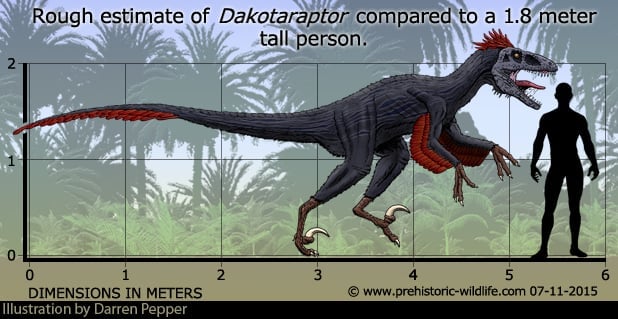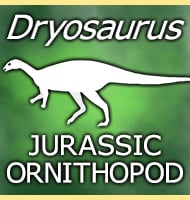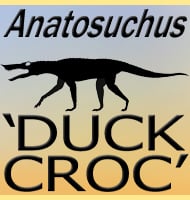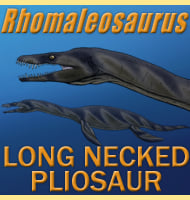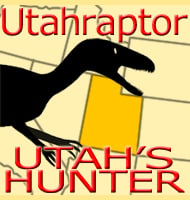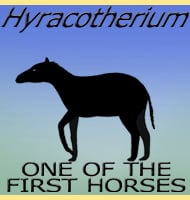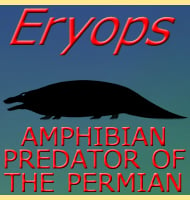In Depth
The one thing that immediately stands out about Dakotaraptor at first glance is simply the large size of this dromaeosaurid dinosaur. Most dromaeosaurid dinosaurs measure in at under two meters in length, with a few genera ranging between two and three meters long. The Holotype individual of Dakotaraptor however has a reconstructed length of five and a half meters. At the time of the 2015 description, this makes Dakotaraptor the second largest dromaeosaurid dinosaur known, with the largest being Utahraptor.
As far as comparison between Dakotaraptor and Utahraptor goes, Utahraptor lived in North America around Utah (clue is in the name) during the Early Cretaceous roughly one hundred and twenty-six million years ago. Dakotaraptor also lived in North America but around South Dakota towards the end of the Late Cretaceous some sixty-six million years ago. Not only are Dakotaraptor and Utahraptor separated by a wide temporal gulf, study of the known fossils of Dakotaraptor show that in body proportions this genus was actually more like genera such as Deinonychus and Dromaeosaurus than it was Utahraptor, making a direct link between Dakotaraptor and Utahraptor unlikely.
Studies of dromaeosaurid dinosaurs going back to the late twentieth century indicate that dromaeosaurid dinosaurs almost certainly had feathers. These feathers were not necessarily all over the body, but were likely on the thorax and abdomen and almost certain on the arms. Dakotaraptor supports this theory in that fossils of the ulna (one of the forearm bones) show attachment points for large pennaceous feathers. It is unknown to what extent feathers would have covered Dakotaraptor, but smaller insulating feathers are known to have covered the body in even larger theropod dinosaurs such as the tyrannosaur Yutyrannus. However other dinosaurs living in North America during the late Cretaceous such as the ornithomimosaur Ornithomimus are known to have had small feathers on the back and sides of the body, but have legs that were devoid of feathers. The coverage of feathers on Dakotaraptor were likely a reflection of environmental factors first, and additional functions such as display and egg insulation second. In the early twenty-first century there has been a lot of debate concerning the relationship between dromaeosaurid dinosaurs and the evolution of birds, with the classic idea being that birds evolved from maniraptoran dinosaurs. There are now alternate theories that maniraptoran dinosaurs may have evolved from birds, or perhaps even to birds and back again, but the ideas are simply too long to explain and off topic for this article. The key point is that some dromaeosaurs may have had a limited flight ability even if only gliding as has been speculated for genera such as Microraptor. As far as Dakotaraptor is concerned, flight was almost certainly an impossibility, mainly for the simple fact that at about five and a half meters long Dakotaraptor would have simply been too big. There was also no way for Dakotaraptor to use its arms to generate anywhere near enough lift. The original study of the forearms of Dakotaraptor into wings, indicated the total ‘wingspan’ of Dakotaraptor would have been about one hundred and twenty centimetres, which is even less than what an average human adult could achieve if they held their arms out to the side.
Although certainly too big to fly, Dakotaraptor was still no slouch on the ground. Proportions of the leg show that the lower leg bones of the tibia and fibula were longer than the femur which makes up the upper leg. This allows for a significantly longer stride of the leg which directly translates to an increase in speed and ability to run fast. The vertebrae of Dakotaraptor were also pneumatised, meaning that they had air spaces within them. This dramatically reduces the weight of the bone, and with this factor in mind, Dakotaraptor would have actually been quite lightweight for its size. Not only would this allow for larger size growth, but it would also allow Dakotaraptor to retain some of the speed and agility that dromaeosaurid dinosaurs are known for.
At the original fossil site of Dakotaraptor, remains of more than one individual were found. The Holotype individual is the most complete of these, however there also seems to have been a notable difference in build between the holotype which is by far the most robust (heavily built), and the others which are more gracile (lightly built). All individuals seem to have been fully grown adults, so one train of thought is that these may represent a collection of male and female individuals. However that still does not make it certain which is which, as while in the animal kingdom males are usually the more robustly built, it is not unknown for females to have been the larger (the moa bird Dinornis is a good example). Only further study and fossil remains can tell us for sure.
Dakotaraptor is the second dromaeosaurid dinosaur known from the Hell Creek Formation, with the first being the much smaller Acheroraptor. The only predator known to have been around at the same time and location and also be bigger than Dakotaraptor is the mighty Tyrannosaurus. Possible prey dinosaurs for Dakotaraptor could include anything from ceratopsian dinosaurs such as Triceratops and Leptoceratops, ankylosaurs and nodosaurs such as Ankylosaurus and Edmontonia, pachycephalosaurs such as Pachycephalosaurus, and hadrosaurs and ornithopods such as Edmontosaurus and Thescelosaurus.
Further Reading
- The First Giant Raptor (Theropoda: Dromaeosauridae) from the Hell Creek Formation. Paleontological Contributions (14). - Robert A. DePalma, David A. Burnham, Larry Dean Martin, Peter Lars Larson & Robert Thomas Bakker - 2015. – The furculae of the dromaeosaurid dinosaur Dakotaraptor steini are trionychid turtle entoplastra. – PeerJ. 3. – V. M. Arbour, L. E. Zanno, D. W. larson, D. C. Wvans & H. Sues – 2015.
